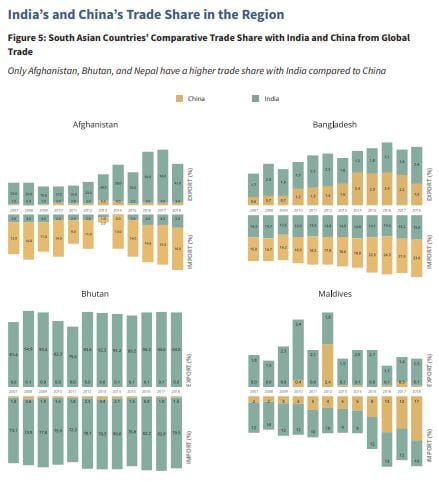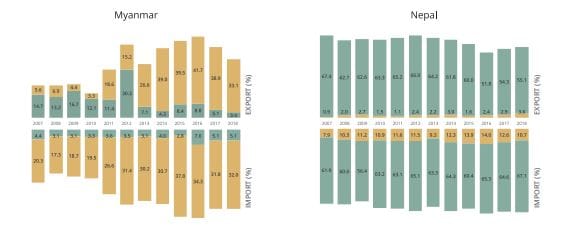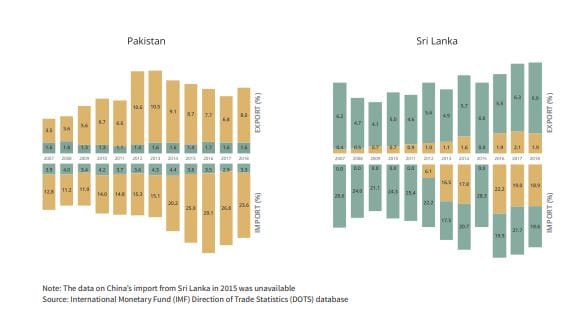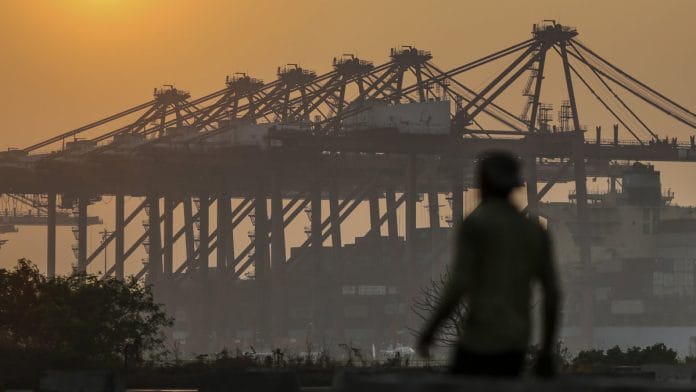Despite geographical proximity and the existence of bilateral and multilateral free trade agreements (FTAs), South Asia is one of the least economically integrated regions in the world. Owing to protectionist policies, high logistics cost, lack of political will and a broader trust deficit, intra-regional trade in South Asia remains well below its potential at 5% of the region’s global trade. This makes South Asia one of the most disconnected regions in the world, especially when compared with other regions such as East Asia and the Pacific, where intra-regional trade accounts for approximately 50% of total trade, and Sub-Saharan Africa, where intra-regional trade has improved over the years to 22% due to the steps taken by governments to create transparent mechanisms for trade facilitation. Intra-regional trade in the South Asian region (including Myanmar) amounts to only 5.6% (2017).
Enhancing intra-regional trade is necessary to increase connectivity in the South Asian region. Facilitated by the flow of goods, services, people, and knowledge, such an initiative would provide access to new markets as well as attract foreign direct investment (FDI) in diverse sectors. The ensuing economic growth would also play a key role in bridging the trust deficit in the region and raise the opportunity cost of conflict.
We analyse the share of India’s trade with its neighbours. The data used is from World Bank’s World Integrated Trade Solution (WITS) database and the International Monetary Fund’s (IMF) Direction of Trade Statistics (DOTS) database. All trade values are in United States dollars (US$). For India’s trade with South Asia, the import and export volumes and shares analysed are from 1988 to 2018; the figures for China’s trade with South Asia (excluding India), however, are from 1992 to 2018. We also analyse trade data for India’s and China’s trade with Afghanistan, Bangladesh, Bhutan, Maldives, Myanmar, Nepal, Pakistan, and Sri Lanka, collectively referred to as ‘South Asia’ or N8.
Also read: Green shoots emerge in world economy as virus lockdowns ease
India’s economic connectivity with South Asia

India’s exports account for the bulk of its trade with its neighbours (Figure 1). The country’s regional trade growth from 1991 until 1999 was minimal. In 2008, India’s trade with the N8 neighbours reached a decadal high of US$13.45 billion. Following a dip in 2009, due to the global financial crisis, India’s trade with its neighbours doubled in the next five years, reaching US$24.69 billion in 2014. The slowdown in India’s exports to South Asia in 2015 and 2016 coincided with the 13% decline in India’s global trade from US$19 trillion in 2014 to US$16.5 trillion in 2015. Intra-regional trade revived in 2017, reaching its peak at US$24.75 billion, picking up further in 2018 when it rose to US$36 billion.
India’s largest export market in the region is Bangladesh, followed by Sri Lanka and Nepal, whereas the largest imports by value come from Myanmar, Sri Lanka and Bangladesh. All countries in the neighbourhood have a trade deficit with India, the highest being Bangladesh with a deficit of US$7.6 billion, followed by Nepal at US$6.8 billion (2018). The trade deficit has been increasing (Figure 1).
Despite the growing trade volume, India’s trade with its neighbourhood has remained roughly between 1.7% and 3.8% of its global trade. Between 1988 and 1996, the country’s trade share doubled as a result of an increase in trade volume and value. This could possibly be attributed to economic liberalisation in Bangladesh, India, Nepal, Pakistan, and Sri Lanka in the 1990s.
Several agreements are in place to facilitate trade in the region. The SAARC Preferential Trading Arrangement (SAPTA) was signed in 1994, followed by the South Asian Free Trade Area (SAFTA) agreement a decade later in 2004 (which came into force in 2006). India’s bilateral trade with Myanmar is conducted under the 1994 Indo-Myanmar Border Trade Agreement as well as the 2009 ASEAN–India Trade in Goods Agreement (AITGA). Additionally, India and Sri Lanka signed the Indo-Sri Lanka Free Trade Agreement (ISFTA) in 1998. The agreement came into force in 2000.
Despite these agreements, trade in the neighbourhood has remained far below its potential. This is exemplary of the fact that agreements by themselves are not enough to facilitate trade unless the barriers to trade are holistically addressed. The presence of para-tariffs, high logistical costs, inadequate infrastructure, and persistent informal trade, coupled with other non-tariff barriers (NTBs), are the key reasons for India’s low intra-regional trade in the neighbourhood. As a result, the cost of trading in South Asia remains unusually high.
A lack of comparative advantage in the region also inhibits the prospects of increasing regional trade as envisioned under SAFTA. Specialisation and value chains are key factors of international trade. Countries with different comparative advantages and product specialisation would have more opportunities to mutually benefit from trade than countries with a high degree of similar products and specialisation. In South Asia, most countries in the region are competitors in their export markets in a narrow range of products, namely textile and apparel exports. India’s major imports are mainly in semi-manufactured items (a consequence of the country’s import policies) for which the neighbouring countries don’t show any comparative advantage. This reflects India’s consistently low imports from its neighbourhood, as seen in Figure 1.
Also read: Asia’s factories remain in doldrums even as lockdowns ease
China: A rising economic partner in the region

Until 2005, India and China were close in their overall trade volume with South Asia. However, after 2005, China consistently increased its trade with South Asia, barring a slight dip in 2009 due to the global financial crisis. In 2014, China’s trade reached a high of US$60.41 billion, whereas India traded approximately one-third of the amount at US$24.70 billion. Following the peak in 2014, both countries saw a decline in trade with South Asia in 2015 and 2016.
China’s strong economic ties with Pakistan as opposed to India’s minimal formal trade with its western neighbour increases the gap in both countries’ trade volumes. Though China’s trade volume is consistently larger, excluding Pakistan (as seen in Figure 2) reduces the gap to almost half. This gap is attributed to the China–Pakistan Free Trade Agreement (CPFTA) signed in 2006, that increased trade significantly between both countries (Figure 5). The corresponding gap between India’s trade with the region is much less because Pakistan’s formal trade share is relatively smaller (Figure 3). Barring Pakistan, the gap between India’s and China’s trade with South Asia (N7) in 2018 is relatively lower at US$ 12.87 Billion (Figure 2).
China’s trade with the N8 neighbours is mainly export-driven (Figure 4), making it a top source of goods to South Asia. Despite the existence of regional and bilateral FTAs, India’s trade volume with its neighbours has remained well below in value to that of China, which has only one FTA in the region (Figure 2).


Only Afghanistan, Bhutan, and Nepal have a higher trade share with India compared to China.



Analysing India and China’s share in the global trade of South Asian countries reveals that only the landlocked countries (Afghanistan, Bhutan, and Nepal) have a higher trade share with India when compared to China (Figure 5). While exports to China from the region have been minimal, imports from China have been growing since 2012 in Myanmar, and since 2014 in the Maldives, Bangladesh, and Pakistan. In the case of Sri Lanka, there was heavy reliance on imports from India till 2013 owing to the Indo-Sri Lanka Free Trade Agreement (ISFTA) that was signed in 1998 and came into force in 2000. However, post-2013, both India and China export at par to Sri Lanka (Figure 5).
In the last two decades, China has established itself as a major trade partner of South Asia. Beyond Pakistan, China has made inroads into South Asia (N8) by becoming Bangladesh’s top trading partner in 2015, and bolstering trade and investment with Nepal, Afghanistan, Maldives and Sri Lanka. This mainly reflects the region’s strategic importance for China’s Belt and Road Initiative (BRI), particularly the smaller South Asian countries.
Also read: Indian traders to skip annual border trade with China via Lipulekh pass due to Covid-19
Strategic importance
Enhancing trade in the South Asian region is not only economically beneficial, it is also strategically important in order to integrate India with the global economy. Regional integration in South Asia requires addressing several NTBs and further reduction of the “sensitive lists” maintained by countries to ensure the effectiveness of trade agreements. Furthermore, good practices from other regions must be tailored to the South Asian context to facilitate the resolution of reported barriers to trade. For instance, Sub-Saharan Africa has addressed NTBs by way of an online mechanism that consists of national monitoring committees in each country to facilitate the resolution of reported trade barriers. For India and her neighbours, stronger political will is required to combat barriers to trade in the region, especially after the COVID-19 crisis which may result in unleashing a new wave of protectionist measures.
Also read: India must stay prepared as it watches China’s ‘not so peaceful’ rise
Policy recommendations
South Asia’s lack of regional connectivity, despite the advantages of proximity, has a long history of mistrust, conflict, and political upheaval. In addition, India’s presence as “big brother” in the region has made its smaller neighbours wary to take the initiative. Moving forward, policies must focus on reducing barriers and facilitating greater connectivity in all spheres in order to build trust and counterbalance China’s growing ties with India’s neighbours. The potential and benefit of trade must be realised by countries in the region to ensure mutual economic gains. The following recommendations draw on the vast literature on trade and regional integration in South Asia.
Also read: The World Trade Organization is hurtling towards irrelevance
Revisiting Free Trade Agreements
The momentum for free trade of the 2000s has been largely lost with India’s neighbours. Trade liberalization initiatives under the Bay of Bengal Initiative for Multi-Sectoral Technical and Economic Cooperation (BIMSTEC) have been under negotiation for more than 15 years. SAFTA and the even bolder idea of a South Asian Economic Union no longer feature in New Delhi’s regional focus today. India’s FTA with Sri Lanka dates back 20 years, and negotiations towards an expanded Comprehensive Economic Partnership Agreement (CEPA) keep getting delayed. Given that the global agenda of multilateral trade liberalisation has stalled, India must redouble its focus on regional trade arrangements. This will require political leadership to sacrifice domestic protectionism in order to pursue long-term strategic interests of greater trade interdependence with its neighbours.
Also read: Modi, Trump had walked away from them. Now mega trade deals will make a comeback after Covid
Eliminating barriers and other protectionist policies
Countries in South Asia must take steps towards elimination of para-tariffs and NTBs. Para-tariffs, which are additional tariffs levied on imports by states, are not a part of SAFTA or any other FTAs in the region. Additionally, NTBs such as import policy barriers, anti-dumping and countervailing measures, testing and certification requirements, export subsidies, and government participation have all curtailed the potential of intra-regional connectivity. Globally, the signing of the Customs Convention on the International Transport of Goods under Cover of TIR Carnets (TIR Convention, 1975) is a positive step towards the elimination of some NTBs and simplifying procedures. To realise South Asia’s trade potential, this model should be replicated at the regional level.
Also read: With FDI move, India can now trade with China from a position of strength
Enhancing cross-border infrastructure
Improvements in cross-border infrastructure such as Integrated Check-Posts (ICPs), road, air and rail links are key to facilitating trade in the region. Improved infrastructure will enable greater connectivity thereby strengthening production networks and value chains in the region. In the last decade, while various steps have been taken to upgrade infrastructure, including the upgrading of land customs stations to ICPs, the extension of rail networks such as the Agartala–Akhaura railway link (Bangladesh) and the Jogbani–Biratnagar railway line (Nepal), or the opening of the second border checkpost between India and Myanmar (Zokhawthar–Rikhawdar). Such improvements in cross-border infrastructure connectivity are the best incentives to increase intra-regional trade.
Riya Sinha @_RiyaSinha is Research Associate and Niara Sareen @niara11849442 is Research Intern, Foreign Policy and Security Studies, at Brookings India. Views are personal.
The article has been extracted from a Brookings India policy brief. Read the full report here.







What a loser….PLA is publicly kicking the butt of Indian army and what is he saying !!!!